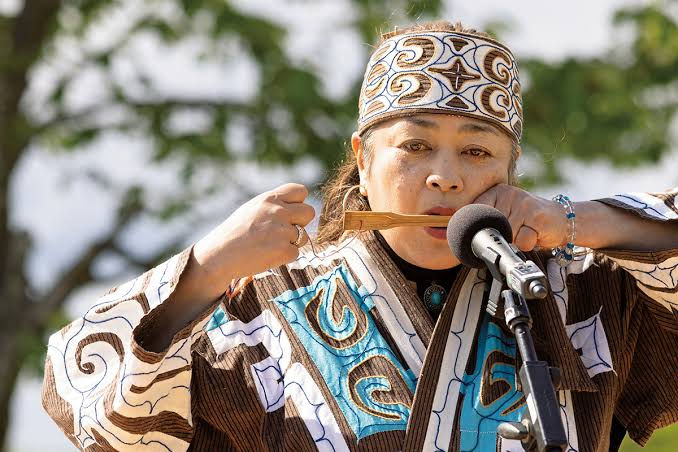The History of the Ainu in Hokkaido
- Phillip Radcliffe
- Jan 7, 2024
- 3 min read
(Japanese Translation below)
By Ayami Nakajima

Ainu culture is said to have been established between the 9th and 13th centuries. The Ainu culture continues to this day, but the Ainu language itself is in danger of disappearing. There are eight languages in Japan that are in danger of disappearing, and Ainu is one of those eight languages.
In Hokkaido, there are many facilities related to the Ainu people, including Lake Akan Ainu Kotan, Upopoi in the town of Shiraoi, the Nibutani Ainu Culture Museum in the Hidaka Region, the Sapporo Ainu Culture Exchange Center, and the Hokkaido Museum. The museum exhibits the history, language and lifestyle of the Ainu people, as well as the folk tools and clothing actually used by the Ainu.

The Ainu people are the indigenous people of the northern part of the Japanese archipelago, particularly in Hokkaido. They have developed a unique culture that includes the Ainu language, which is a language of a different lineage from Japanese. The Ainu have a spiritual culture in which it is believed that everything in nature has a soul. Ancient dances are performed at festivals and family events and crafts such as embroidery and wood carving with unique patterns are still made.
According to a survey conducted last year in Hokkaido, only 0.7 percent of the more than 13,000 Ainu people who are estimated to be living in the prefecture said they could converse in Ainu. It is one of the languages in danger of disappearing.
The Ainu language began Its decline during the Meiji period (1868-1912). The policy of assimilation of the Ainu people, including education in Japanese, has been pushed forward, and as a result, the Ainu language has rapidly disappeared from daily life.
Today, most of the Ainu people live in Sapporo and other cities in Hokkaido. There are also many Ainu who have moved outside of Hokkaido to places such as Tokyo and Osaka to pursue higher education, find employment, or get married, and are now living in their own communities.
Even today, there are many movements to tell the story of the Ainu people. Various Ainu-related sites and museums have preserved the Ainu culture, and the good qualities of the Ainu people continue to be conveyed through “Golden Kamuy,” an animation series set in Hokkaido, and through traditional Ainu dances performed at opening ceremonies and other events.
北海道におけるアイヌの歴史
中島 絢未
アイヌ文化は9世紀から13世紀にかけて成立したと言われている。アイヌ文化は現在も続いているが、アイヌ語そのものは消滅の危機に瀕している。日本には消滅の危機に瀕している言語が8つあり、アイヌ語はそのうちの1つである。
アイヌ民族は、日本列島北部、特に北海道の先住民族である。日本語とは異なる系統の言語であるアイヌ語を含む独自の文化を育んできた。アイヌは、自然界のすべてのものに魂が宿ると信じられている精神文化を持っている。祭りや家族行事では古式ゆかしい踊りが披露され、刺繍や木彫りなど独特の文様を持つ工芸品も作られている。
北海道が昨年行った調査によると、道内に1万3000人以上いると推定されるアイヌ人のうち、アイヌ語で会話ができると答えた人はわずか0.7%だった。アイヌ語は消滅の危機に瀕している言語のひとつである。
アイヌ語が衰退し始めたのは明治時代(1868-1912)である。日本語教育を含むアイヌ民族の同化政策が推し進められ、アイヌ語は日常生活から急速に姿を消した。現在、アイヌの人々の多くは札幌をはじめとする北海道の都市に住んでいる。また、進学や就職、結婚を機に東京や大阪など道外に移住し、それぞれの地域で暮らすアイヌも多い。
現在でもアイヌ民族を伝えようとする動きは多い。さまざまなアイヌ関連施設や博物館がアイヌ文化を保存し、北海道には、阿寒湖アイヌコタン、白老町のウポポイ、日高地方の二風谷アイヌ文化博物館、札幌アイヌ文化交流センター、北海道博物館など、アイヌ民族に関する施設が数多くある。アイヌの歴史や言語、生活様式、実際にアイヌが使っていた民具や衣服などが展示されている。また、北海道を舞台にしたアニメ『ゴールデンカムイ』や、オープニングセレモニーなどで披露されるアイヌの伝統舞踊がアイヌの良さを伝え続けている。



